| Kitty Leroy - from Wikipedia
Kitty Leroy (1850 – December 6, 1877) was a dancer, gambler,
saloon owner, prostitute, madam, and trick shooter of the American Old
West.
Leroy was born in Michigan and by the age of 10 she was
dancing professionally. By the time she was fourteen she was performing
in dance halls and saloons. She also had developed shooting skills that
few could match, including the ability to shoot apples off people's heads.
She married for the first time by 15, but the marriage was short-lived.
She ventured west seeking her fortune, settling for a time in Dallas, Texas.
By the age of 20, she had married a second time and was one of the most
popular dancing attractions in town. She soon gave up dancing to work as
a faro dealer and became known for dressing in men's clothing, and at times
like a Romani. By this time, Leroy had developed into a skilled gambler.
She and her second husband headed to California, where
they hoped to open their own saloon. Somewhere along the line, she left
him for another man, marrying for a third time. However, this marriage
was extremely short-lived. According to an unconfirmed legend, the two
became involved in an argument, during which she challenged him to a gunfight.
When he refused to fight her because she was a woman, she changed into
men's clothing and challenged him again. When she drew her gun, he did
not, and she shot him. As he did not die right away, she called for a preacher
and the two were married. He died within a few days.
Leroy made her way to Deadwood, Dakota Territory, in 1876,
traveling in the same wagon train as Calamity Jane and Wild Bill Hickok.
There, she worked as a prostitute in the brothel managed by Mollie Johnson.
She opened the Mint Gambling Saloon and married for a fourth time to a
Prussian prospector. However, when his money ran out, they began to argue
often. She hit him over the head with a bottle one night and threw him
out, ending the relationship.
Her saloon was successful. In addition to the gambling
income, Leroy occasionally worked as a prostitute but mostly managed her
own women. On June 11, 1877, Leroy married for the fifth and final time,
this time to prospector and gambler Samuel R. Curley. This marriage, as
her others, was volatile. Curley was alleged to have been extremely jealous
and Leroy continued to have affairs, one of which was with her latest ex-husband,
and another, according to rumor, with Wild Bill Hickok. On the night of
December 6, 1877, Curley shot and killed Leroy in the Lone Star Saloon,
then turned the gun on himself and committed suicide. The pair were laid
in state in front of the saloon the next day, then buried together. The
January 7, 1878 issue of the Black Hills Daily Times of Deadwood, under
"City and Vicinity", reported:
The estate of Kitty Curley upon appraisment,
amounted to $650. More than one-half of which is c[l]aimed by and allowed
to
Kitty Donally, and the ezpenses have
doubtless consumed the balance. P.H. Earley has been appointed trustee
or guardian
for the child.
She is mentioned in the HBO series Deadwood, portrayed
as a beautiful murder victim
|
Seth Linman - from Wikipedia
| Seth Kinman (September 29, 1815 – February 24, 1888)
was an early settler of Humboldt County, California, a hunter based in
Fort Humboldt, a famous chair maker, and a nationally recognized entertainer.
He stood over 6 ft (1.83 m) tall and was known for his hunting prowess
and his brutality toward bears and Indians. Kinman claimed to have shot
a total of over 800 grizzly bears, and, in a single month, over 50 elk.
He was also a hotel keeper, saloon keeper, and a musician who performed
for President Lincoln on a fiddle made from the skull of a mule.
Known for his publicity seeking, Kinman appeared as a
stereotypical mountain man dressed in buckskins on the U.S. east coast
and selling cartes de visites of himself and his famous chairs. The chairs
were made from elkhorns and grizzly bear skins and given to U.S. Presidents.
Presidents so honored include James Buchanan, Abraham Lincoln, Andrew Johnson,
and Rutherford Hayes. He may have had a special relationship with President
Lincoln, appearing in at least two of Lincoln's funeral corteges, and claiming
to have witnessed Lincoln's assassination.
His autobiography, dictated to a scribe in 1876, was first
published in 2010 and is noted for putting "the entertainment value of
a story ahead of the strict facts." His descriptions of events change with
his retelling of them. Contemporary journalists and modern writers were
clearly aware of the stories contained in the autobiography, "but each
chooses which version to accept."
Early life |
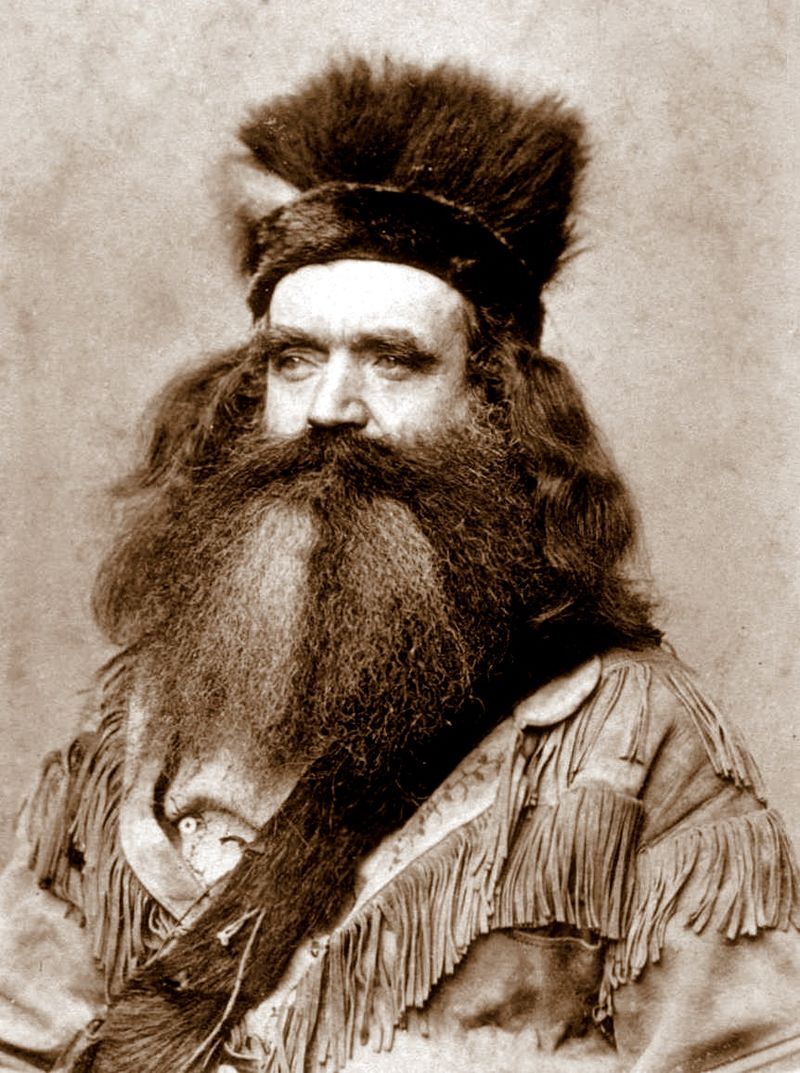 |
Seth Kinman's father, James Kinman, ran a ferry across the
West Branch Susquehanna River in central Pennsylvania, in an area then
called Uniontown, now called Allenwood in Gregg Township, Union County.
James also was a millwright and an inn-keeper, whose forebears were Quakers
from Bucks County, Pennsylvania. Seth's mother, Eleanor Bower Kinman, was
of German descent whose family lived in Reading, Pennsylvania. Seth was
born in Uniontown in 1815. While in Pennsylvania, he learned to read and
write, "I could form good letters with a pen but I never learned to spell
well." In 1830 his father took the family and migrated to Tazewell County,
Illinois.
In his autobiography, Seth stated that his father fought
in the Blackhawk War in Illinois in 1832. He also claimed that his father
and Abraham Lincoln fought together in the war, became friends afterward,
and that Seth met the future president during Lincoln's circuit-riding
days in Illinois. At about the same time the Kinmans acquired a rifle,
known as "Old Cotton Bale," that Seth kept throughout his life. The rifle
had a 4 ft (1.2 m) long barrel and "is supposed to have killed Gen'l Peckenham"
at the Battle of New Orleans in 1815. With some skepticism, Anspach relates
a long history of the rifle, gleaned from an 1864 local newspaper story
on Kinman, of a renegade Kentucky sniper shooting the British general while
carrying on a conversation with American General Andrew Jackson.
Seth spent ten years working in his father's mill in
Illinois, sawing lumber and grinding grain. After his father's death in
1839 he sold the mill and tried farming. He married Anna Maria Sharpless,
of Catawissa, Pennsylvania, in 1840 and they had five children together:
James (1842), Carlin, who is sometimes called Calvin (1846), Austin (1847),
Ellen (1849), and Roderick (1851). Anna Maria and two of their sons, James
and Austin, died during the winter of 1852-53, while Seth was in California.
By 1848 Kinman was operating the Eagle Hotel in Pekin,
Illinois, on the Illinois River. The hotel was known less for its comforts
than for Kinman's rendition of the fiddle tune Arkansas Traveler.
A traveler came off a steamboat one day
and went to the Eagle Hotel. There had been a little western "scrimmage"
at the "Eagle" the
night before, and though things had not
been put in order, the proprietor, Seth Kinman, was sitting in front of
the door, playing his favorite
tune, the "Arkansaw Traveler", with the
greatest self-satisfaction.
The stranger, stopping, said to Seth:
"Are you the proprietor here?"
Seth, without resting his bow, replied-
"Wall, I reckon I be, stranger".
"Do you keep tavern?"
"Of course I do: I keep tavern like
h—l," said Seth, fiddling away with all his might, "Just pile in: hang
your freight on the floor, and make yourself at home." "The boys," continued
Seth, "have been having a little fun, but if there is a whole table or
plate in the house, I'll get you some cold hash toward night." The stranger
didn't like this peculiarly western reception, so took his departure, leaving
Kinman still enjoying his violin.
Life in California
Kinman claimed to have migrated to California in 1849
during the great Gold Rush and worked as a prospector in Pierson B. Reading's
party on the Trinity River near present day Douglas City. He then returned
to Illinois for two years. In 1852, he travelled to California and explored
the Humboldt Bay area, near present day Eureka, California. Humboldt Bay
had been recently rediscovered by gold miners seeking a faster and cheaper
route to transport supplies. An early settlement in the area was also named
Uniontown, but is now known as Arcata. During this period, prospectors
and their suppliers were often flush with gold, but had little to spend
it on.
On Christmas, 1852 Kinman was hired to perform on fiddle
at the then exorbitant amount of $50, despite his lack of musical training.
As described by a fellow '49er:
Seth Kinman, the noted hunter and antler
chair-maker, and myself were tendered fifty dollars each to preside as
the orchestra for a
Christmas ball at Uniontown in 1852. Kinman's
repertoire consisted mainly of an alternation of the "Arkansaw Traveler"
and "Hell on the
Wabash" and mine was little more varied
or pretentious. He responded. My conscience has not yet reached that level
of elasticity.
—David Rohrer Leepe
Over the winter of 1852-53 he lived in what is now Ferndale
in the cabin of Stephen Shaw. His wife and two of their children died that
winter, and he may have gone back to Illinois to bring back his mother
and three remaining children by 1854. In 1853 he started working as a hunter,
feeding U.S. troops in Fort Humboldt. While at Fort Humboldt he met future
president Ulysses S. Grant, and future General George Crook. According
to tradition, about this time, he brought the first herd of cattle to Humboldt
County.
Some events and their timing are unclear during this early
period. Sources disagree on whether he brought his family to California
from Illinois in 1852 or 1854. Carranco dates Seth's first return to Illinois
starting in 1850, with his return to California in August 1852, his arrival
in Humboldt County in February 1853, another return to Illinois in September
1853, and a trip back to California starting in May 1854 with his mother,
two children, and a herd of cattle. Thus, in the course of the six years
1849-1854, he is believed to have crossed the Great Plains, Rocky Mountains,
and the Sierra Nevada Mountains five times, travelling mostly on foot.
Kinman lived in several places in the county, including
houses near Fern Cottage and a dairy farm on Bear River Ridge. He bought
80 acres (320,000 m2) of farm or ranch land 1 mi (1.6 km) east of the future
Table Bluff Lighthouse in October 1858, and about 10 mi (16 km) south of
Fort Humboldt. This was the first purchase of land in the Humboldt Land
District, which was established by an Act of Congress in March 1858. He
later built a hotel and bar on the site.
Kinman made his name first as a hunter, especially as
a hunter of grizzly bears. California was noted for its large population
of grizzlies. Seth's son Carlin claimed that they once saw 40 grizzlies
at one time. But by 1868, the last grizzly in Humboldt County had been
killed. While Kinman was on his way to deliver one of the presidential
chairs, he met Methodist bishop and writer Oscar Penn Fitzgerald on a California
steamboat. Fitzgerald recorded his impressions in the sketch The Ethics
of Grizzly Hunting. He presented Kinman as a drunkard who cruelly abused
Indians and grizzly bears.
His countenance was expressive of a
mixture of brutality, cunning, and good humor. He was a thorough animal.
Wild frontier life had not
sublimated this old sinner in the
way pictured by writers who romance about such things at a distance.
—Oscar Penn Fitzgerald
Kinman's eyes made a special impression on Fitzgerald.
Decades later he compared Kinman's eyes to those of the California bandit
Tiburcio Vásquez, "His eyes were nature's special label of one of
her malignest creations. Only in two other human beings have I ever seen
such eyes as those.... It was the eye of a wild beast, the baleful glitter
you have seen in the eyes of snakes, panthers, catamounts, or other creatures
of the reptile or feline kind."
During a gale on the night of January 5–6, 1860, Kinman
was alerted by distress signals from the Northerner which had been breached
by a submerged rock. Kinman tethered himself to the shore and waded into
the surf to rescue passengers. In all, 70 people were saved by various
means and 38 people perished. He was hailed as a hero and awarded a Bible
and free life-time passage on the Pacific Mail Steamship Company's ships.
Relations with Native Americans
Native Americans in northern California suffered greatly
at the hands of European-Americans in the last half of the 19th century,
and their population decline is often characterized as genocide. The Wiyot
people, who lived around Humboldt Bay, were particularly hard hit. Their
population declined from about 1,500-2,000 in 1850 to about 200 in 1860.
Kinman's brutality was noted by James R. Duff, a fellow
'49er, who described him as "an avowed enemy of the red man, ... (who)
shot an Indian on sight." Carranco states that "Seth always took an Indian
along on a hunt - partly to carry the game, but primarily to serve as bear
bait," and concludes "sometimes he regarded them (Indians) as human beings
... other times, only as predatory animals to shoot at."[30] Kinman himself
claimed to be an official Indian agent, though there is little evidence
that he actually served in the position. He collected "Indian artifacts"
including scalps, which he claimed to have taken himself.
Kinman was involved with the Wiyot people who lived on
Table Bluff, near his farm. The Wiyot continue to live on Table Bluff on
a small rancheria or reservation. The key event in Wiyot history was the
February 25–26, 1860 Wiyot Massacre on Indian Island, when over one hundred
Wiyot were murdered in their sleep. At the same time there were massacres
of the Wiyot at other sites, possibly including Table Bluff. Kinman has
not been specifically identified as one of the murderers. Nevertheless,
in May 1860 he was elected to represent Bear River at a county-wide meeting
ostensibly called to discuss ways to protect white settlers from the Indians.
In 1864 he scouted for Captain William Hull's California Volunteers, which
according to Kinman, "slaughtered and captured Indians, and at one time
they took as many as 160 captives to Fort Humboldt."
Life as an entertainer
While delivering an elkhorn chair to President Buchanan
in 1857, Kinman said, "l awoke one fine morning and found myself famous."
He made use of this fame starting in the summer of 1861, together with
ventriloquist and magician J. G. Kenyon, by opening an exhibit, first in
Eureka and then in San Francisco in August of that same year. Kinman displayed
his "curiosities" including an elkhorn chair, mounted grizzly bears, several
fiddles, and scalps, and gave a lecture.
How they shouted and yelled when I
related some of my old 'bar' stories and hair-breadth escapes, and played
on that fiddle made out of the
skull bones. That got them! I would wind
up on the "Arkansas Traveler" and their enthusiasm wound up to the highest
pitch. Before I
fetched my 'bar', I would horrify them by
telling them how the 'bar' tore Indian children to pieces, and how I finally
trapped the 'bar' with a
young dead Indian. Then the 'bar' was led
out by a chain, and he would dance before he unbuttoned himself and out
stepped a man. Then I
had to explain about the 'bar' skin. Then
I told the audience how I sawed off those Indian scalps the ladies looked
horrified and aghast. Then I
would tell about the Indian way of life.
I would finish up by describing my elkhorn chair and how I had constructed
it.
—Seth Kinman
| They then toured gold mining camps and the San Francisco
Bay area as entertainers. Later he opened a traveling "museums of curiosities"
in Eureka, San Francisco, Sacramento and Los Angeles.
During his trip to the East Coast in 1864-1866, Kinman
exhibited his curiosities including his chairs, primarily in Pennsylvania
and Illinois. He took a ten-year-old Native American boy, named Burtch
or Burtchfield, with him on this trip, but Burtch died in December, 1864.
Kinman said that he took the boy on the trip because he had killed both
of Burtch's parents.
Kinman may have also displayed his chairs at the Philadelphia
Centennial Exposition in 1876. As late as 1885, Kinman opened a museum
in Los Angeles with his sons Carlin and Roderick.
Presidential chairs
Kinman first used the large number of elkhorns shed near
his farm every year to create a fence. With the help of George Hill, about
1856 he created his first elkhorn chair, which he traded to Dr. Josiah
Simpson of Fort Humboldt for a telescope. The construction of an elkhorn
chair included using matching horns to make the front legs and arms of
the chair. These horns interlocked with another matching pair, which formed
the rear legs and the back of the chair. An elk-hide seat was added, along
with actual elk feet as the feet of the chair, and the horns were connected
beneath the seat.
Inspired by the 1856 election of James Buchanan, a fellow
Pennsylvanian, to the presidency, Kinman built his first presidential elkhorn
chair and brought it to Washington. |
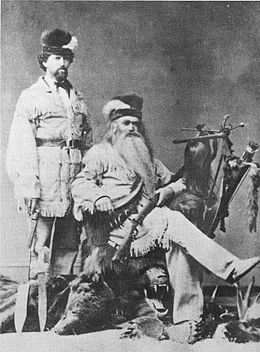
Seth (seated) with his son Carlin,
displaying a few curiosities in 1876 |
I kill deer and elk meat up in Humboldt County.
My range is from Bear Valley into Oregon.
This winter I killed considerable meat so
I thought I would take it easy and set about to make
this cheer with a view of sending it on
to Washington for Old Buck. After I got it finished,
though, the boys up in our parts thought
it enough to travel on; so I thought I would try and
go on with it to Washington myself, leaving
my mother and four children behind, and started
with nothing but my rifle and powder horn.
Nobody has yet sot in this cheer, and never shall
till after the President.
—Seth Kinman
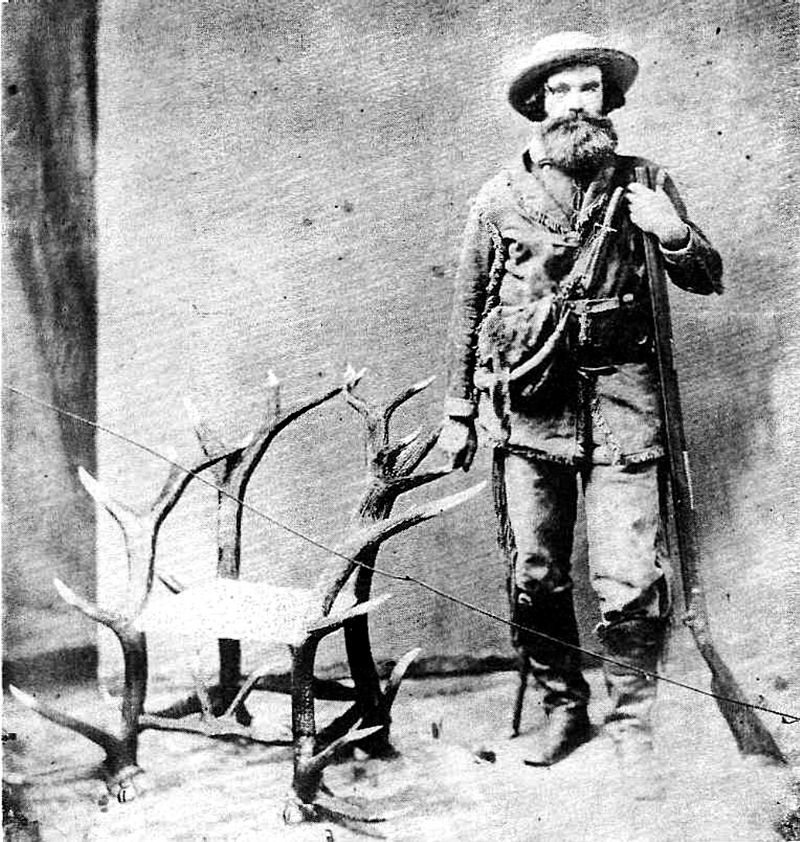
Kinman 1n 1857 with the chair he
presented to Buchanan. |
He arranged free passage on the ship Golden Age to Panama,
then to New York, and finally to Washington. With some help from Peter
Donahue and O.M. Wozencraft, on May 26, 1857, after an introduction from
the Commissioner of Indian Affairs James W. Denver, Kinman presented the
chair to Buchanan. The President was so pleased by the present that he
bought Kinman a rifle and two pistols in return.
In 1861 he advertised that he had made a chair that he
would present to Napoleon III. Later, because of French involvement in
Mexico, he abandoned the idea. Kinman took two chairs on his 1864 trip
to the East Coast for use in exhibitions.
Kinman's presentation of an elkhorn chair to President
Abraham Lincoln at 10 a.m. on Saturday, November 26, 1864 was recorded
by artist Alfred Waud, the only known picture of Lincoln accepting a gift.
The drawing shows Lincoln examining Kinman's rifle, which he called "Ol'
Cottonblossum." Kinman also presented a fiddle made from the skull and
a rib of his favorite mule and played the instrument.
Much to the amusement of Lincoln and
other spectators, he played 'Essence of Old Virginia'
and 'John Brown' on the bones of the
mule. Lincoln said that if he could play the fiddle he
would ask him for it, but since he
could not, the fiddle would be better off in Mr. Kinman's
hands.
—Stanley Kimmel.
|
Within three weeks, Lincoln stated that he would prefer to
eat Kinman's chair, antlers and all, than to appoint a certain office-seeker.
The following April, Kinman marched in President Lincoln's
funeral cortege in Washington
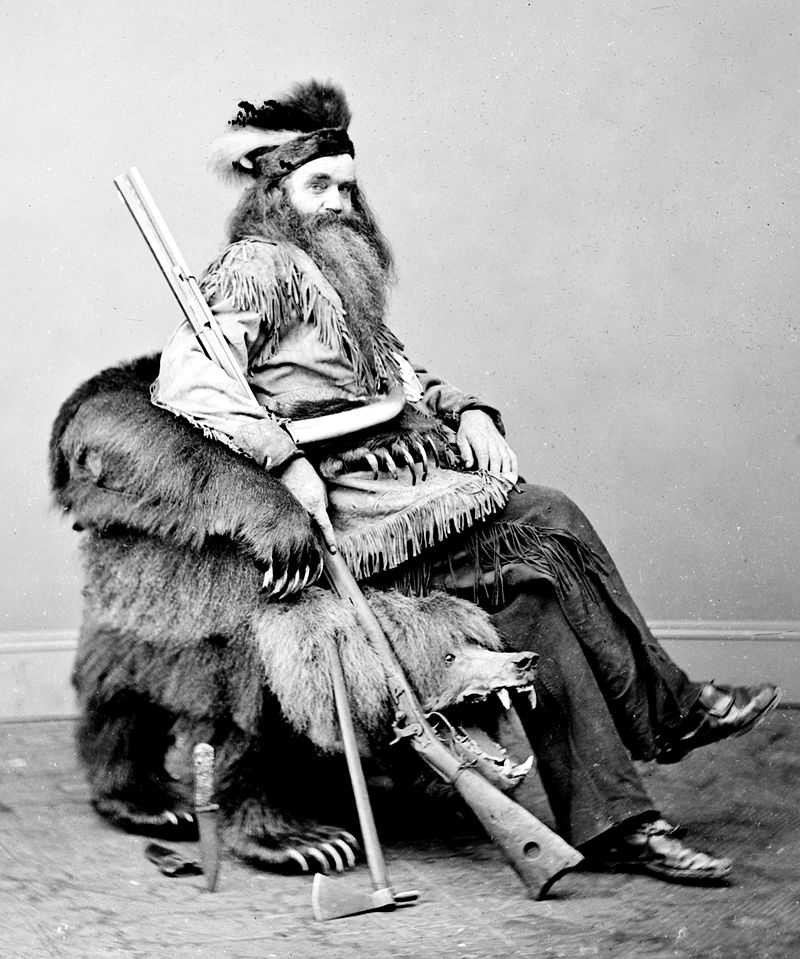
Kinman in the chair he presented to
President Andrew Johnson in 1865 |
Kinman was allegedly in Ford's Theater the night of the
assassination and witnessed the murder. He escorted Lincoln's body on its
way to burial as far as Columbus, Ohio. On April 26, 1865, the New York
Times described Kinman in the funeral cortege in New York City: "Much attention
was attracted to Mr. Kinman, who walked in a full hunting suit of buckskin
and fur, rifle on shoulder. Mr. Kinman, it will be remembered, presented
to Mr. Lincoln some time ago a chair made of California elk-horn, and continuing
his acquaintance with him, it is said, enjoyed quite a long conversation
with him the very day before the murder."
During his stays on the East Coast, many cartes de visites
photographs of Kinman and his chairs were taken by Mathew Brady. Kinman
claimed to have paid Brady $2,100 in one three-month period for photos
at 8 cents apiece, which calculates to an unlikely amount of over 26,000
photographs. Kinman sold these photographs, among other places, in the
U.S. Capitol. He also toured the country, performing in his buckskins as
a frontier story teller and fiddle player.
Kinman's tour de force in presidential chairs was presented
to President Andrew Johnson on September 8, 1865.
This was intended to surpass all his
previous efforts, and was made from two grizzly bears
captured by Seth. The four legs and
claws were those of a huge grizzly and the back and
sides ornamented with immense claws.
The seat was soft and exceedingly comfortable,
but the great feature of the chair
was that, by touching a cord, the head of the monster grizzly
bear with jaws extended, would dart
out in front from under the seat, snapping and gnashing
its teeth as natural as life.
—Marshall R. Anspach |
| Johnson kept the chair in his White House library, the
Yellow Oval Room.
On September 18, 1876, Kinman presented an elkhorn chair
to Governor Rutherford Hayes of Ohio, who was soon to become the President
of the United States. The chair is now displayed in the Rutherford B. Hayes
Presidential Center in Fremont, Ohio. He later gave a chair constructed
of bearskin and other bear body parts to Hayes's vice-president William
A. Wheeler.
Legacy
In 1876, Kinman dictated his memoirs, but they were not
published until 2010. He also kept an extensive scrapbook of newspaper
articles. About 1930, a one-time neighbor of Kinman, George Richmond, copied
the memoirs and the scrapbook by hand. The original manuscript and scrapbook
were then sent to a potential publisher or agent, and lost after his death.
The published version is from Richmond's copy. Richmond also recalled many
of Kinman's stories and collected others from Kinman's family and friends,
then retold these stories in a book now published as I'm a Gonna Tell Ya
a Yarn. |
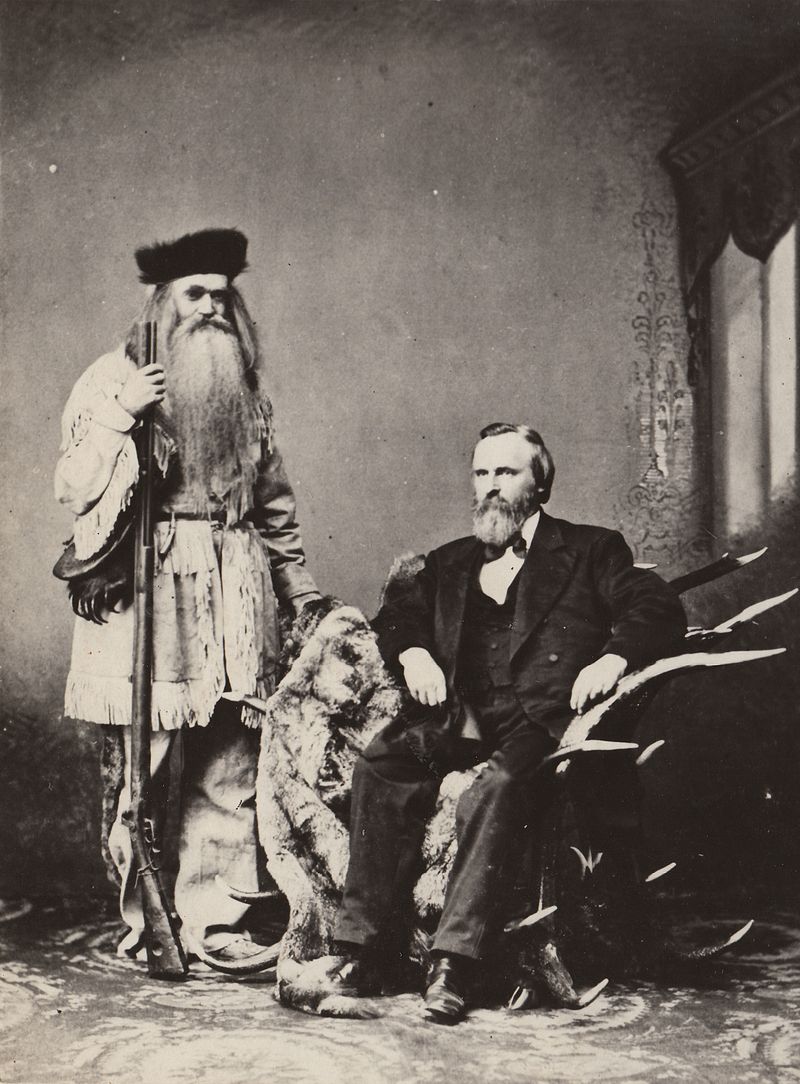
Kinman and Governor Rutherford B. Hayes
on September 18, 1876 |
In his later years, Kinman lived in Table Bluff, California
with his family, where he owned a hotel and bar. In 1886, Kinman was preparing
to send chairs to President Grover Cleveland and former presidential candidate
General Winfield Scott Hancock. He died in 1888 after accidentally shooting
himself in the leg. He was interred at Table Bluff Cemetery in Loleta,
California, in his buckskin clothing.
Mrs. R.F. Herrick bought Kinman's traveling museum collection
of 186 items, including at least two of his famous chairs, and displayed
them in San Francisco in 1893. She then took the collection to Chicago
to display them at the 1893 World's Columbian Exposition, where she reportedly
sold the individual items. The Clarke Historical Museum in Eureka displays
a suit of his buckskins, complete with beaded moccasins, as well as a wooden
chest he owned. The Ferndale Museum displays several Kinman items, including
another of his buckskin suits.
|